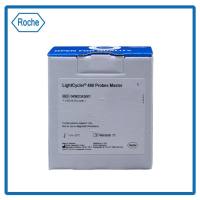Direct Fluorochrome-Labeled DNA Probes for Direct Fluorescent In Situ Hybridization to Chromosomes
互联网
801
Chromosomal in situ hybridization enables determination of the presence and location of DNA sequences complementary to a labeled probe along chromosomes and within interphase nuclei. The use of directly fluorochrome-labeled probes means that sites of probe hybridization can be directly visualized. Lengthy detection procedures, as in the indirect immunochemistry methods to detect biotin or digoxigenin, are not needed. However, because there is no signal amplification, sensitivity is limited and the system is used mostly to detect middle- to high-copy number (Fig. 1 ) or pooled probes, although antibody amplification of some fluorochrome labels is possible ( 1 ), and then the method must be evaluated in comparison with digoxigenin (chapter 27 ) or biotin (chapter 25 ).
Fig. 1. Direct fluorescent double in situ hybridization to a partial metaphase of a hexaploid wheat variety carrying a rye translocation (1B/1R). (A) Bright fluorescence of the rye chromosome arms probed with rhodamine-labeled total genomic DNA from rye after green excitation (arrow heads), with the wheat chromosomes fluorescing weakly. (B) Strong fluorescence of the fluorescein-labeled rDNA under blue excitation. rDNA sites can be distinguished on several wheat chromosomes (arrows) and the two rye arms (open arrows). Bar = 10 �m.








